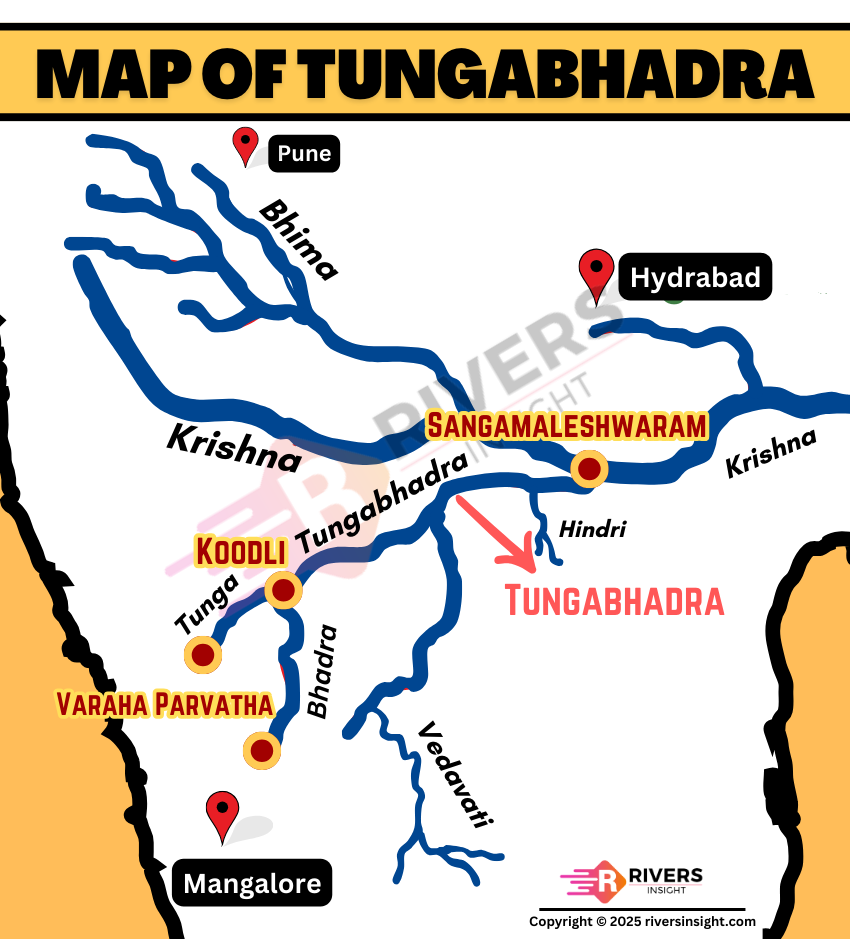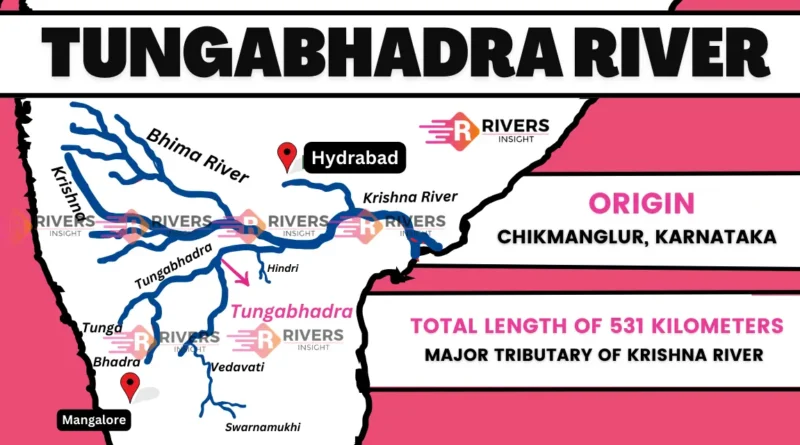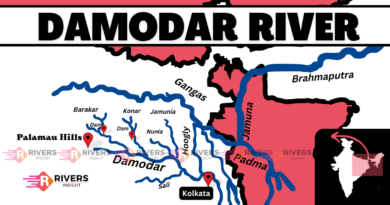Tungabhadra River: Origin, States & Map from Start to End
Tungabhadra River is located in southern India, flowing through the states of Karnataka and Andhra Pradesh. It originates from Koodli in Karnataka, where the Tunga River and the Bhadra River meet, making this confluence the birthplace of the Tungabhadra River. From this starting point, the river travels a length of 531 km before joining the Krishna River.
| Location | Southern India |
| Origin | Koodli, Karnataka |
| Tunga River Origin | Gangamoola Hills |
| Bhadra River Origin | Bhadra Wildlife Sanctuary |
| Length | 531 km |
| Flows Through | Karnataka and Andhra Pradesh |
| End Point | Sangamaleshwaram |
Table of Contents
Where is the Tungabhadra River Located?
The Tungabhadra River is located in South India, flowing through two states — Karnataka and Andhra Pradesh. It starts in Karnataka, flows eastward, and joins the Krishna River in Andhra Pradesh.
Origin of the Tungabhadra River
The Tungabhadra River originates at Koodli, near Shimoga district in the state of Karnataka, where two rivers—the Tunga River and the Bhadra River—meet and give birth to the Tungabhadra.
- Tunga River Origin: The Tunga River originates from the Gangamoola hills (also known as Varaha Parvatha) in the Western Ghats, located in Chikkamagaluru district, Karnataka.
- Bhadra River Origin: The Bhadra River takes its origin from the Bhadra Wildlife Sanctuary, also in the Western Ghats, near Samse village in Chikkamagaluru district, Karnataka.
These two rivers flow independently for a short distance and then converge at Koodli, a sacred spot near Shivamogga, forming the Tungabhadra River, which then continues its journey eastward.
This confluence point is regarded as the birthplace of the Tungabhadra River, making it not only geographically important but also spiritually significant.
Course
After originating at Koodli in Karnataka, it flows in a southeast direction, covering a total length of approximately 531 kilometers. It traverses through two major Indian states—Karnataka and Andhra Pradesh—before merging with the Krishna River.
States the Tungabhadra River Flows Through:
- Karnataka
- Andhra Pradesh
Key Cities and Regions Along the Course:
- Shimoga (near the origin point)
- Hospet
- Hampi (a UNESCO World Heritage Site on the riverbanks)
- Koppal
- Bellary
- Mantralayam (a major pilgrimage site in Andhra Pradesh)
Confluence and Final Destination:
The river finally merges with the Krishna River at Sangamaleshwaram in Andhra Pradesh, becoming part of the larger Krishna basin that eventually flows into the Bay of Bengal.
Map: Tungabhadra River – Start to End

Tributaries
The River is fed by several important tributaries:
- Tunga River
- Bhadra River
- Varada River
- Hagari River
Dams
- Tunga Anicut Dam
- Bhadra Dam
- Hemavathy Dam
- Tungabhadra Dam
Tungabhadra Dam
The Tungabhadra Dam is located near Hospet in the Koppal district of Karnataka. It is a multipurpose gravity dam built across the Tungabhadra River, primarily designed for water storage and energy generation.
Capacity Details:
- Full Reservoir Level (FRL): 1,633 feet
- Present Reservoir Level: Around 1,621.32 feet
- Gross Storage Capacity: Approx. 105.79 TMC (Thousand Million Cubic feet)
- Live Storage Capacity: Around 64.22 TMC
Historical Significance
The Tungabhadra River, once known as Pampa, is rich in cultural and historical significance. In Hindu mythology, Pampa, the daughter of Brahma, performed penance to please Lord Shiva. Impressed by her devotion, Shiva married her, taking the name Pampapati (husband of Pampa). The city of Hampi derives its name from Pampa.
The river is also a sacred site, with numerous temples and shrines dedicated to Lord Shiva along its banks, especially near Hampi. Some of the prominent temples include:
- Virupaksha Temple
- Vittala Temple
- Achyutaraya Temple
- Hazara Rama Temple
The Tungabhadra is not just a lifeline for agriculture and ancient civilizations—it is also revered as one of the important rivers in India due to its mythological relevance and its contribution to the prosperity of the Vijayanagar Empire. This makes it both a sacred river and a historically vital waterway.
FAQs
Q. What is the length of the Tungabhadra River?
A. The river flows for approximately 531 kilometers.
Where does the Tungabhadra River originate from?
A. It originates from the confluence of the Tunga and Bhadra rivers in Koodli, Karnataka.




